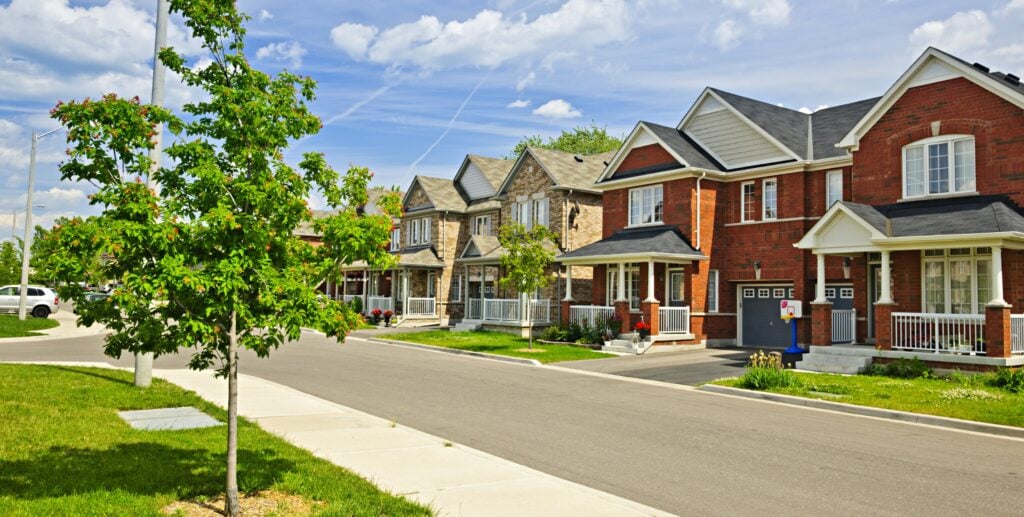Rezoning, major precinct plans, and housing strategies are set to unlock hundreds of thousands of new homes nationwide.
Across Australia, governments are fast-tracking rezonings and masterplanned communities to meet rising housing demand.
With the National Housing Accord setting a goal of enabling the construction of 1.2 million new homes by mid‑2029, state and local governments have unveiled plans to meet this target and cater for future population growth.
Under the National Housing Accord, Australia aims to build 1.2 million new homes by mid-2029. Picture: Getty
From coastal towns to emerging suburbs, we’ve ranked the top 10 areas for future housing growth based on announcements made since the start of 2025.
10. Redland City, Queensland – 8000 homes
The Queensland government has introduced a Priority Development Area (PDA) which could deliver 8000 new homes in Redland City.
A PDA is a designated zone designed to deliver development projects to meet community needs and stimulate economic growth.
Spanning 890 hectares in Southern Thornlands, 32km east of Brisbane’s CBD, the PDA’s initial release will provide land for 900 homes, with 20% set aside for affordable and social housing.
9. St Marys, NSW – 9300 homes
Under NSW’s Transport Oriented Development (TOD) program, St Marys in Western Sydney is set to gain more than 9300 new homes by 2041.
The TOD initiative focuses on increasing density within 400 metres of train stations. Councils have submitted plans for these hubs to ensure housing targets are met, with NSW Planning Minister Paul Scully saying the program could deliver more than 170,000 new homes statewide.
Penrith City Council’s plans for St Marys include supporting light industry, a consolidated commercial core with co-working and creative spaces, and new public open spaces.
8. Greater Hobart, Tasmania – 10,000 homes
In May 2025, the Tasmanian government expanded the Urban Growth Boundary across Greater Hobart, opening up land for 10,000 new homes.
The Tasmanian government has expanded the Urban Growth Boundary to enable land for 10,000 homes. Picture: Getty
The 615 hectares includes suburbs Brighton, Clarence, Kingborough and Sorell. The boundary defines urban land limits, guiding residential growth in line with infrastructure and service planning.
7. Woollahra, NSW – 10,000 homes
In August 2025, the NSW government confirmed it would finish the Woollahra train station and enable 10,000 new homes by rezoning land around it and the Edgecliff station.
In Woollahra station’s north and into Edgecliff, the primary zone is R3. But to the south of the station, this medium-density zone is only about two blocks wide, with the zoning quickly stepping down to R2.
The government has made it clear that higher density housing will be accommodated around the station and into Edgecliff, so these zones are set to change.
If R4 zoning is introduced, that could allow for high-rise living, often in larger apartment complexes.
6. Concordia, South Australia – 12,000 homes
Barossa Valley’s Concordia will see 12,000 new homes following the rezoning of 984 hectares land from rural to residential.
Identified as a strategic growth area in 2023, the Concordia Code Amendment will enable a masterplanned community expected to house 25,000–30,000 residents over the next 30 years.
5. Beveridge North West, Victoria – 15,000 homes
In August 2025, the Victorian government approved the Beveridge North West Precinct Structure Plan (PSP), paving the way for 15,000 new homes in Mitchell Shire, 40km north of Melbourne.
Beveridge North West is expected have 15,000 new homes, 40km north of Melbourne. Picture: Getty
The PSP will include four town centres, eight schools and 79 hectares of green space, with the first 2400 homes delivered across 140 hectares.
4. Burwood North, NSW – 15,000 homes
The NSW government will fast-track rezoning of the Burwood North Metro Precinct to deliver up to 15,000 homes around the future Sydney Metro West station.
The precinct spans Burwood and Canada Bay LGAs, with both councils submitting masterplans for residential and infrastructure growth.
3. Broadmeadow, NSW – 20,000 homes
Broadmeadow in Newcastle is set for 20,000 new homes under a state-led rezoning of 313 hectares.
Four government-owned sites form the core of the masterplan, with new pedestrian links, green spaces and transport improvements. Between 5% and 10% of the homes are earmarked for affordable housing.
2. North Perth, Western Australia – 50,000 homes
The East Wanneroo development area – covering suburbs such as Wanneroo, Mariginiup, Gnangara, Jandabup and Pinjar – will deliver 50,000 new homes.
In WA, the East Wanneroo development area is set to deliver 50,000 homes. Picture: Getty
Approved in August 2025, the first three precinct plans account for environmental, planning and water management considerations, with Gnangara the future economic hub.
1. Greater Adelaide, South Australia – 61,000 homes
Changes to South Australia’s Environment and Food Production Areas will enable up to 61,000 homes across Roseworthy, Two Wells, Murray Bridge, Victor Harbor and Goolwa.
Part of the Greater Adelaide Regional Plan, this is the largest single rezoning announced in 2025, contributing to a target of 315,000 new homes over the next three decades.
Are you interested in development news? Check out our New Homes section.



















 English (US) ·
English (US) ·